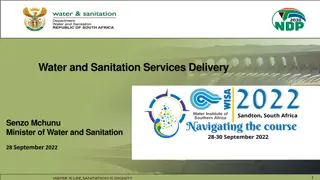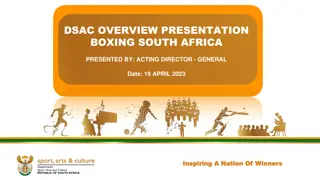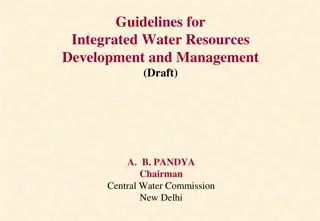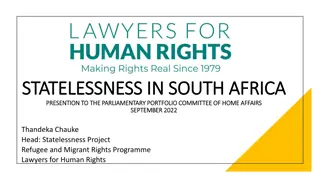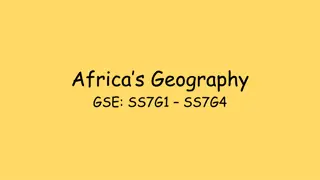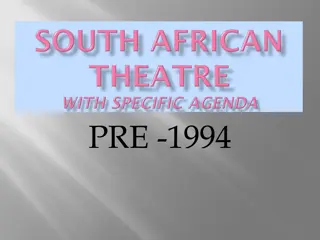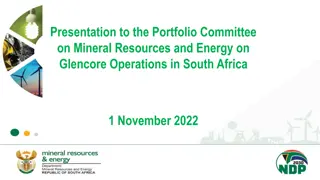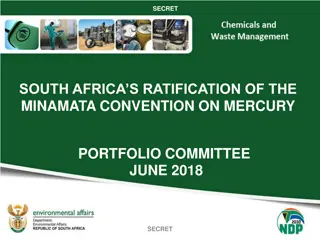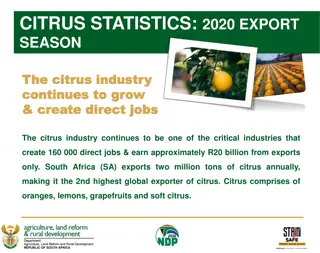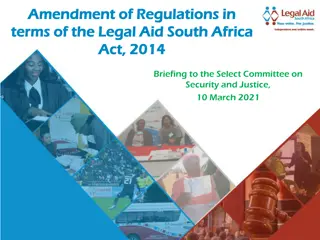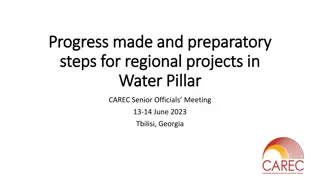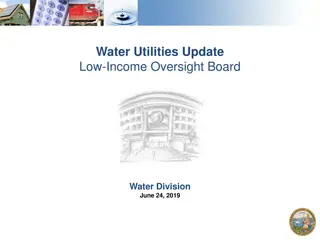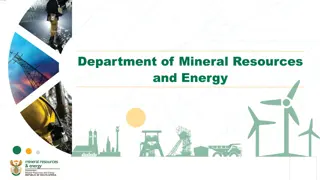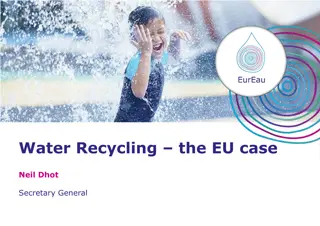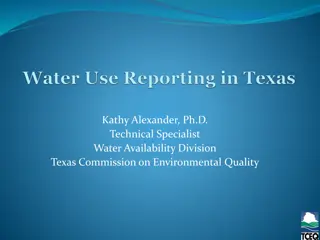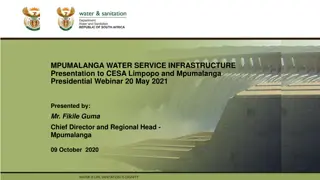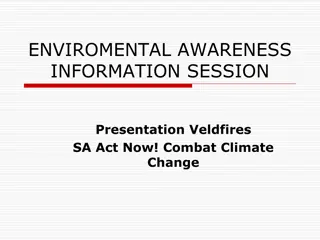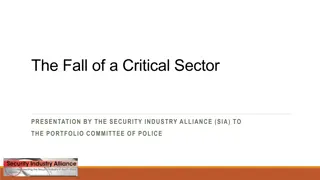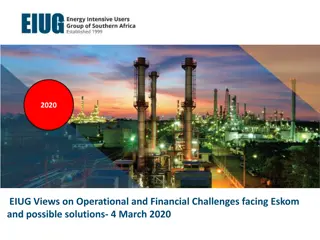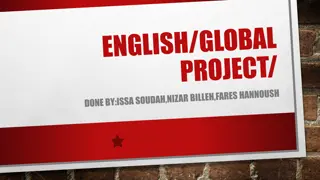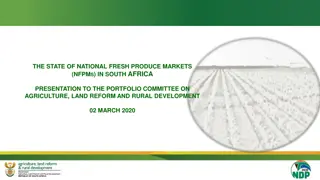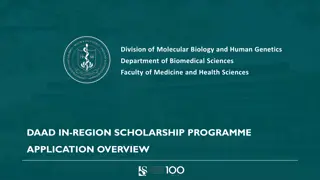Ensuring Water Security in South Africa: Challenges and Solutions
Water security is a critical concern globally, with billions facing water scarcity issues. South Africa, a water-scarce nation, must manage its water resources sustainably. The webinar discusses water security risks, conventional and non-conventional approaches, and suggested solutions. Socio-economic factors play a significant role in water scarcity, highlighting the need for political will, investment in infrastructure, and inclusive policies to address challenges effectively.
Download Presentation

Please find below an Image/Link to download the presentation.
The content on the website is provided AS IS for your information and personal use only. It may not be sold, licensed, or shared on other websites without obtaining consent from the author. Download presentation by click this link. If you encounter any issues during the download, it is possible that the publisher has removed the file from their server.
E N D
Presentation Transcript
WATER SECURITY IN SOUTH AFRICA Water Security: Is South Africa Optimally Pursuing its Options? Dr Jerry Mutamba RAND WATER: WATER SERVICES FORUM Virtual Webinar: 22 June 2022 1
PRESENTATION LAYOUT INTRODUCTION GLOBAL VIEW ON WATER SECURITY SA s WATER RESOURCES SITUATION WATER SUCURITY RISK MANEGEMENT: WATER RESOURCE OPTIONS CONVENTIONAL APPROACHES NON-CONVENTIONAL APPROACHES SUGGESTED SOLUTIONS TO MANAGE WATER SECURITY RISK 2
Our Challenge & Food For Thought The world runs on water. Ample, clean water is vital for human health, industry, agriculture and energy production. Yet the world s water systems face formidable threats due to unsustainable management & climate change. 3
INTRODUCTION Water is a crucial input to domestic, agricultural, industrial, & other production activities; it is a source of livelihoods & prosperity to many. However, water is a scarce resource in most parts of the world: About 4 billion people experience severe water scarcity in at least one month of the year. 700 million people worldwide could be displaced by intense water scarcity by 2030. Given its pivotal & influential role (& scarcity), countries should sustainably manage their water resources. South Africa is expected to do the same its one of those water scarce countries. 4
GLOBAL WATER SECURITY Water security is the reliable availability of an acceptable quantity & quality of water for health, livelihoods, & production coupled with an acceptable level of water-related risk (Grey & Sadoff (2006). Water insecurity is a global phenomenon (more finite statistics): Over 760 million people are estimated to have no access to safe drinking water (Water Aid, 2012). 2.3 billion people live in water-stressed countries, of which 733 million live in high and critically water-stressed countries (UN Water, 2021). 1.4 billion people including 450 million children live in areas of high or extremely high-water vulnerability (UNICEF, 2021) 5
GLOBAL WATER SECURITY The primary problem is not physical scarcity but socio-economic water scarcity; scarcity caused by a lack of investment in water infrastructure or insufficient human capacity to satisfy the demand of water. Socio-economic water scarcity is a function of political power, policies, & socio-economic relations, including: Lack of or insufficient political will (decision power lies in politics). Inadequate investment in requisite water infrastructure projects. Lack of skills to plan & manage projects. Exclusion of certain groups because of inability to pay, political affiliation, disability, race or social status. 6
SA WATER SITUATION News24 13 June 2022 Nelson Mandela Bay closer to Day Zero as first dam's levels drop too low for water extraction Nicole McCain 7
SA WATER SITUATION: Resource Balance South Africa is one of the water-stressed countries in the world; ranked as the 30th driest country globally (Green Cape, 2017). Country is mainly reliant on surface water (77%), while groundwater supplies 9%, & return flows 15% (DWA, 2013). SA s reliable surface water yield is estimated to be 14 200 Mm3/yr (NT, 2011), & utilisable groundwater is 3 500 Mm3/yr (DWA, 2011). Total national yield is thus estimated to be 17 700Mm3/yr. As of 2015, South Africa s water demand was estimated to be 15 000 Mm3/yr (WWF, 2016), & projected to be 17 000 Mm3/yr by 2025. 8
SA WATER SITUATION: Resource Balance Demand is estimated to outstrip sustainable supply by 2025 (NT, 2011); while more recent research suggest that water demand will exceed yield by as early as 2017 (WWF, 2016). South Africa proneness to drought: Over the past 8-10 years, almost all parts of South Africa experienced severe drought episodes. In 2017/18 drought affected the Eastern Cape, Northern Cape & the Western Cape. The drought incident was so severe that CPT was projected to be running out of water by June of 2018 the Day Zero. Currently (2022), several areas in the Nelson Mandela Bay are projected to be running out of water this month (June 22) due to low dam levels (less than 3%) & drought. 9
SA WATER SITUATION: Resource Balance South Africa drought history: In 1991/92 drought is ranked as one of the worst drought SA has ever experienced. In 2002/03, South Africa also experienced another severe drought. In 2014/16, 6 of the 9 provinces suffered drought, resulting in significant water shortages. In 2018, the Western Cape (Day Zero), Northern Cape and KwaZulu Natal Provinces had devastating droughts. In 2019, the Eastern Cape, Limpopo, Gauteng, North West, Mpumalanga & the Free State province incurred water shortages (DWS, 2019). Since 1970, the intensity & duration of droughts has increased. Key questions are: have we mastered the management of droughts, & are our water systems resilient?
SA WATER SITUATION: Resource Management It should be acknowledged that South Africa has considerably advanced water management systems. This includes several (more than 15 such schemes) complex inter-basin transfer schemes designed to balance supply & demand across the country. This includes the world-renowned binational water transfer from Lesotho, the Lesotho Highlands Water Project. However, South Africa s broader water management needs to improve to ensure the country meets current & future general & strategic needs. 11
SA WATER SITUATION: Key Challenges & Areas of Improvement South Africa is naturally water stressed (physical water scarcity), with most of the river basins & water management areas already in deficit. Water requirements continue growing: growing population, improving livelihoods, industrial growth, & agricultural development. Aging infrastructure, with poor maintenance Unabated high water losses. Continued deterioration of the quality of water in rivers due to anthropogenic-related pollution (ref slide on river pollution). Country is vulnerable and is exposed to the ravaging effects of climate change, particularly the effects of long term droughts. 12
SA WATER SITUATION: Resource Balance
WATER RESOURCES MGMT OPTIONS South Africa needs to look at how it can improve its national water security going into the future. Optimal combinations need to be considered for the country s best outcomes; these should include both conventional approaches & non- conventional approaches. 14
WATER RESOURCES MGMT OPTIONS: Conventional Approaches Key among conventional options are: Exploration of new groundwater and surface water resources. Use of advanced engineering in pursuit of ITBs. However, 98% of South Arica s affordable & viable surface water resources have been allocated. With most of the surface water resources almost allocated, there is very little room for cheap & easy to access water resources to tap into. For a country with 41% NRW, considerable room exist to improve, gaining efficiencies in water use per capita through demand management & conservation strategies. 15
WATER RESOURCES MGMT OPTIONS: Non-conventional Approaches Severe resource scarcity always call for a shift from traditional approaches to new historically non-conventional options. This approach requires careful & professional steps, that do not expose people to undue risk. Under growing water resource limitations, it is time South Africa embraces and, timeously, start incorporating non-conventional options such as sea water desalination & wastewater reclamation options. Although widely investigated, these options have not gained much practical traction. 16
POTENTIAL ACTIONS Create public awareness & ensure buy-in around water security initiatives. Improve accessibility to research results, including implementation of R&D outcomes. Incentivising less popular measures like water reuse & WCDM even upscale existing reuse technologies. Apply a system-based approach to managing water , looking at the cycle from cloud to coast, taking into account implications upstream & downstream. Consider all types of water: green water, blue water & grey water.
POTENTIAL ACTIONS cont d Invest in the right infrastructure, i.e. right infrastructure is built in the right place. Infrastructure is built properly & is sustainable. Sustainable operation & maintenance of infrastructure e.g. number of taps that could no longer supply reliable water increased by about 2 million between 2011 & 2015. Promotion of virtual water in the form of goods & services from other countries global cooperation.
POTENTIAL ACTIONS cont d Regulation of water to focus on IWRM & sustainability. Too often there is a lack of synergy between long-term water resource mgt & the need to provide water & sanitation services. Behavioural changes required by individuals, communities & industry may speak to how water is valued. Improve political will (often doubted) to authentically address issues. Devise innovative funding mechanisms Public finance still account for 70% of investment in domestic water supply but public funding is facing competing demands particularly in periods of low economic growth.
CONCLUDING REMARKS Business as usual will mean the world will lose the trajectory to robust and resilient water systems & the ability of ecosystems to provide fresh water supplies will become increasingly compromised. Effective management will mean tackling neglected issues such as: water wastage in current systems, which has been estimated to be up to 35%; common institutional dysfunction; unethical practices; poor accountability; & corruption in the water sector. We need to build resilient water systems through improved investment in water infrastructure & management. We need to move beyond simply ticking off sustainability indicators to true sustainability in the water sector.
MUTAMBA JERRY Telephone: (+27) 12 683 1200 THANK YOU E-mail: info@tcta.co.za Website: http://www.tcta.co.za 21



